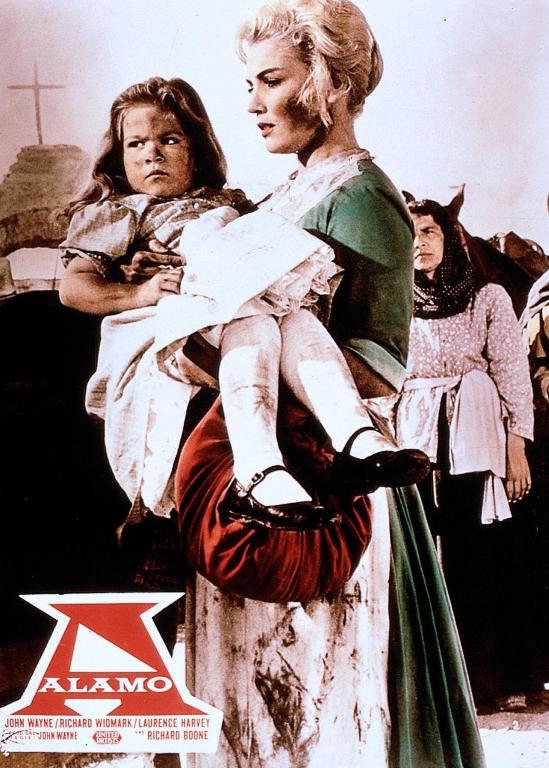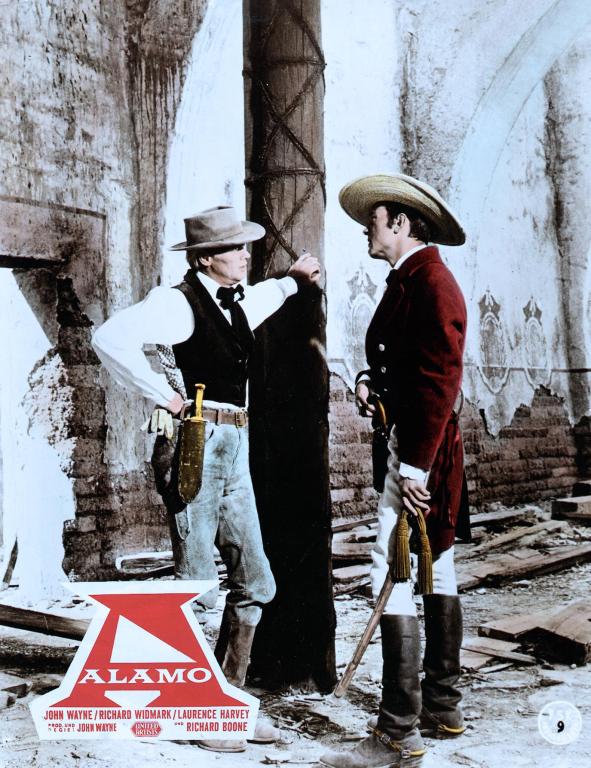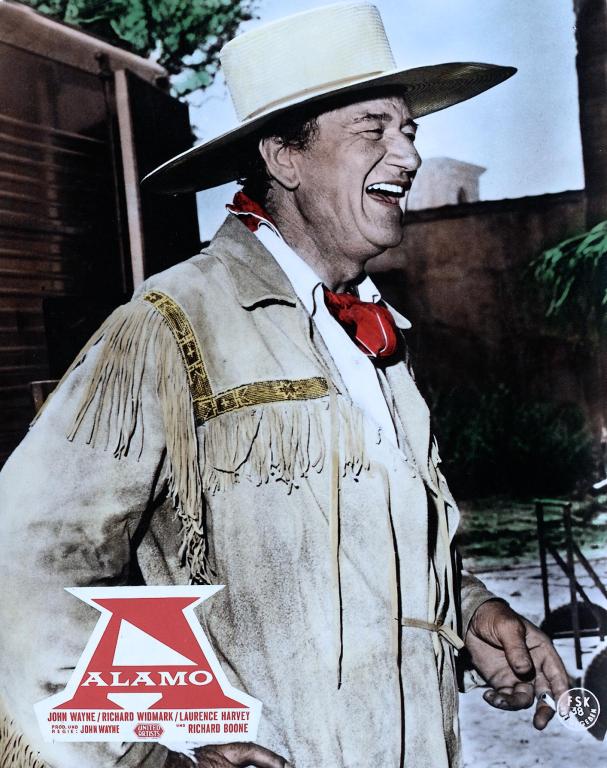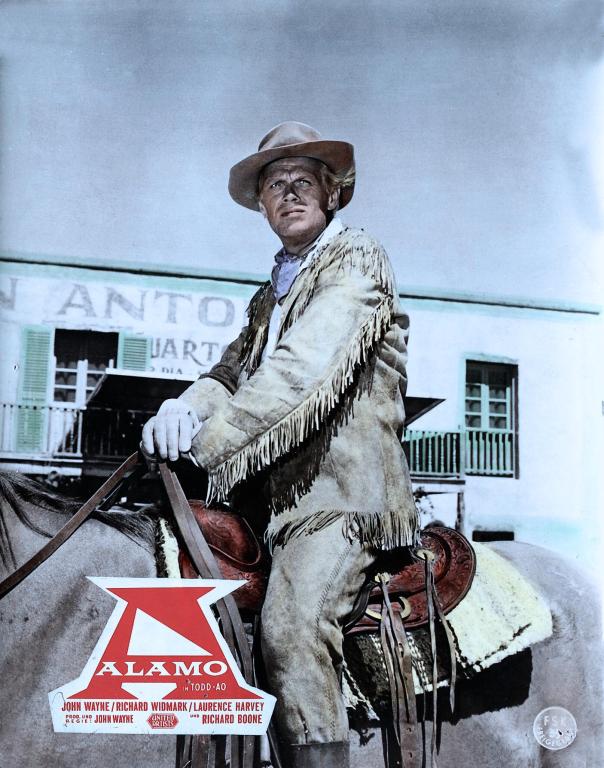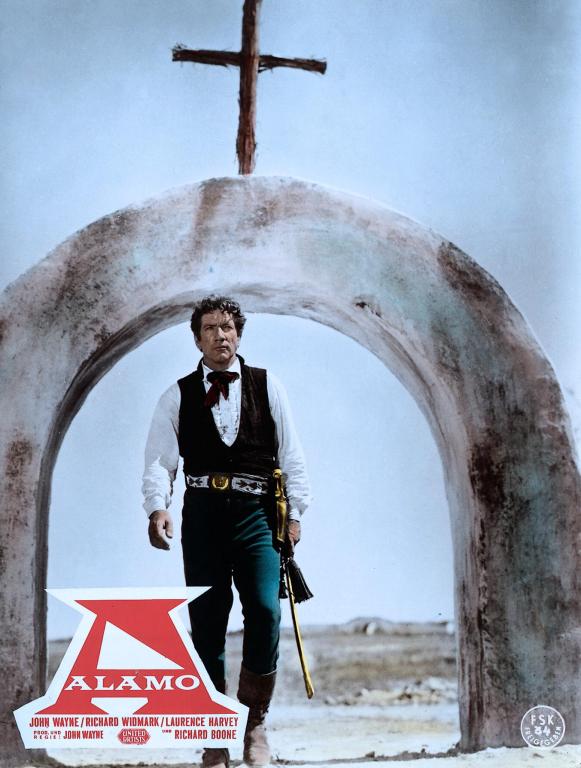The Alamo
| Year | 1960 |
|---|---|
| Country | USA |
| Tagline | NOW! For Those Who Missed It! AGAIN! For Those Who Saw It...and Can't Forget It! |
| Director | John Wayne |
| Cinematography | William H. Clothier |
| Scriptwriters | James Edward Grant |
| Produced | John WayneJames Edward GrantMichael Wayne |
| Music | Dimitri Tiomkin |
| Art Direction | Alfred YbarraRon TalskyVictor A. Gangelin |
| Editing | Stuart Gilmore |
| Genres | DramaAdventureWesternMilitaryHistory |
| USA Gross | $17 262 932сборы |
| Release Date | October 24, 1960 |
| Runtime | 140 min. |
Plot Summary
Did You Know?
In the battle scenes in total, it employs 7,000 people and 1,500 horses.
The shooting lasted for 83 days, while the scenery of the Fort was built within two years.
In early 1945, John Wayne decided to create a film about the 1836 battle for the fortress of Alamo.
When the script of the film was nearing completion, Wayne and the President of the "Republic Pictures", Herbert Jets, arguing over three million of the film's budget. Wayne ended it with "Republic Pictures", but the original script to collect failed. It was later rewritten and embodied in the movie "the Last command" (eng. "The Last Command").
After the break with the "Republic", Wayne and producer Robert fellows founded his own company "Batjac". Wayne continued to work on creating their version of the movie about the Alamo. Having come to the conclusion that, under the directing influence of the pattern may differ from the expected result, he decides to shoot and produce it yourself. Wayne was counting on just that, but he has failed to enlist the financial support of the project, which would ensure his appearance on the screen. In 1956, he signed an agreement with "United Artists" (UA). UA has invested in the development of the film's $ 2.5 million and were its distributor. In return it was expected that "Batjac" will invest another 1.5 $ 2.5 million, and Wayne will play a major role. Wayne secured the remainder of funding from wealthy Texans who insisted that the film was shot in Texas.
A film set was built not far from Brackettville, Texas, on the ranch of James Shahan. Chatto with Rodriguez was the main contractor of the scenery. In preparation for their establishment, Rodriguez paved 14-mile (23 km) of paved roads, allowing you to easily deliver to Brackettville necessary equipment. In addition, its people have drilled six wells, which could provide 12,000 gallons of water daily, laid miles of water and sewer lines. They've also fenced off the 5000 acres (2000 hectares) of horse paddocks.
Hundreds of thousands are laid manually Adobe bricks created a wall of the former mission the Alamo. Sets were recreated three-quarters of the mission buildings, and has since been used for filming more than a hundred other westerns, including a new film version of the battle of 1836. More than two years spent on the construction of a complex of buildings of the Alamo.
It was originally planned that Wayne will play Houston, a small role that would allow him to focus on his first directorial work. However, the main investors insisted that he played one of the main characters of the tape, so Wayne chose the character Davy Crockett, and the role of Houston went to Richard Boone.
In the tense moments of filming Lawrence Harvey entertained the audience by quoting lines from Shakespeare with a Texas accent.
Some of the roles in the film went to relatives and close friends of Wayne, including his daughter Aissa.
Sammy Davis Jr. was asked by Wayne to give him the role of a slave so he could entertain the audience with their song and dance. However, some of the producers of the film prevented this move, apparently because Davis then met with white actress may Britt.
A few days after the start of filming't Widmark Richard tried to leave the project, explaining that it is not suitable for this role. However, after threats of lawsuits over the failure of the contract he agreed to stay until the end.
Coach Wayne, John Ford, although he was not invited, also came to help to shoot the film and to coordinate the actions of the learner. In order to maintain its control over the picture that Wayne sent him out to shoot episodes of the second plan. And although almost nothing of shooting Ford in the film, was not, Ford is often mistakenly referred to as not listed in the credits the Director.
Actors such as't Widmark complained that Wayne was trying to tell them how to play a particular episode, even if it was contrary to their ideas of character.
Some actors, for example, Frankie avalon, were intimidated by the numerous pit Viper. Crickets were everywhere, often ruining shoot the episodes when they are in the time of the filming the actors jumped on the shoulders, or loud chatter during conversations.
In the film manufacturing process, the authors faced a number of troubles, most tragic of which was the murder of one of the extras, Legina Eldridge, due to a private domestic dispute concerning the filming. Another incident happened with Laurence Harvey, when he forgot about the recoil from firing the gun. In the scene in which Travis firing at a Mexican messenger, after the shot the weapon is rolled back, comes over Harvey's leg, breaking it he did not utter a sound until Wayne said: "Cut!". Wayne responded to the incident: "Professional!"
Shooting ended 15 December 1959. A total of 560 000 feet of film consisting of 566 scenes. Despite this incredible amount of footage, the shooting lasted three weeks longer than planned. At the end of the installation, the duration of the film was three hours and thirteen minutes.
To coordinate a media campaign for promotion of the movie Wayne hired Russell Birdwell. Birdwell believed that a successful media campaign is one that makes the news. He persuaded the authorities of seven States to declare "the Day of the Alamo" during the premiere of the tape. And sent the message to elementary schools across the United States with a request to educate children about the Alamo.



